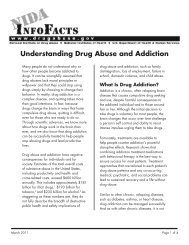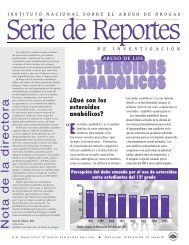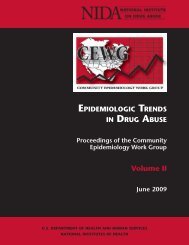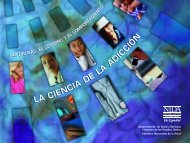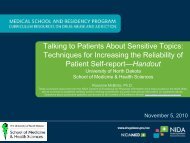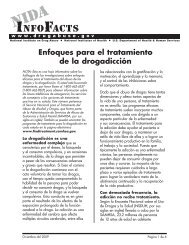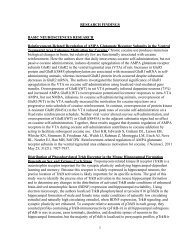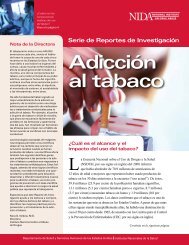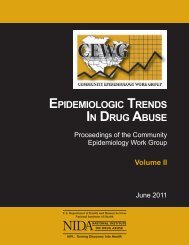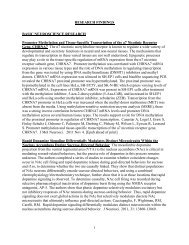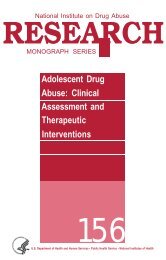CEWG January 09 Full Report - National Institute on Drug Abuse
CEWG January 09 Full Report - National Institute on Drug Abuse
CEWG January 09 Full Report - National Institute on Drug Abuse
Create successful ePaper yourself
Turn your PDF publications into a flip-book with our unique Google optimized e-Paper software.
EpidEmiologic TrEnds in drug AbusE: HigHligHTs And ExEcuTivE summAry<br />
by Whites at “raves”. Phencyclidine (PCP) use<br />
was increasing, and gamma hydroxybutyrate<br />
(GHB) numbers were low and mixed. Carisoprodol<br />
(Soma ) remained a problem, and there<br />
were increasing<br />
®<br />
menti<strong>on</strong>s of dextromethorphan<br />
(DXM) by young users. Of recent c<strong>on</strong>cern is Salvia<br />
divinorum, but it is diffcult for pois<strong>on</strong> centers<br />
to identify the correct species.<br />
Updated Indicators and Emerging Patterns:<br />
Alcohol was the primary drug for which<br />
Texans enter treatment (27 percent of all admissi<strong>on</strong>s)<br />
in this reporting period, followed by<br />
cocaine (12 percent crack and 10 percent powder<br />
cocaine). Cocaine was a major problem <strong>on</strong> the<br />
border with Mexico. Indicators of cocaine use<br />
remained high but mixed, with increasing crack<br />
use am<strong>on</strong>g Whites and Hispanics. The proporti<strong>on</strong><br />
of Black crack admissi<strong>on</strong>s has dropped from<br />
75 percent in 1993 to 47 percent in 2008, and<br />
the proporti<strong>on</strong> of cocaine deaths who were Hispanic<br />
has increased from 22 percent in 1993 to<br />
33 percent in 2007. Heroin indicators were low<br />
and level, but the proporti<strong>on</strong> who were inhaling<br />
or sniffng heroin was growing (up from 1 percent<br />
in 1989 to 20 percent in 2008), with an increasing<br />
proporti<strong>on</strong> of younger Hispanic inhalers of<br />
Mexican brown powder. Arrests and overdoses<br />
of “cheese heroin,” a mixture of Tylenol PM<br />
®<br />
and heroin (a combinati<strong>on</strong> of heroin, diphenhydramine,<br />
and acetaminophen), were down in<br />
Dallas, but treatment admissi<strong>on</strong>s of young heroin<br />
users were increasing statewide. Hydrocod<strong>on</strong>e<br />
was a larger problem than oxycod<strong>on</strong>e (359 deaths<br />
versus 63 deaths in 2007). Indicators of problems<br />
with fentanyl patches or lozenges were low; they<br />
fluctuate from year to year. Methad<strong>on</strong>e indicators<br />
were increasing, and most adverse events<br />
were related to methad<strong>on</strong>e pain pills rather than<br />
liquid methad<strong>on</strong>e from narcotic treatment programs.<br />
Codeine cough syrup, “Lean,” c<strong>on</strong>tinued<br />
to be abused. Marijuana indicators were mixed,<br />
with blunt cigars c<strong>on</strong>tinuing to be used. The 2008<br />
Texas sec<strong>on</strong>dary school survey reported that 8<br />
percent of all students who reported ever having<br />
used marijuana used blunts most of the time<br />
or always, as compared with 6 percent who used<br />
“joints” 6 percent who used pipes, and 4 percent<br />
who used “b<strong>on</strong>gs.” In additi<strong>on</strong>, marijuana is a far<br />
larger problem than alcohol for underage drivers<br />
who entered treatment as a result of a DUI (driving<br />
under the influence) (63 percent compared<br />
with 21 percent). Methamphetamine indicators<br />
peaked in 2005. The price of a pound of “ice”<br />
in Dallas has increased from $4,500–$19,000 in<br />
2005 to $13,000–$20,000 in 2008. The purity of<br />
ice was lower, since it is being cut with methylsulf<strong>on</strong>ylmethane<br />
(MSM). <strong>Abuse</strong> of alprazolam<br />
and carisoprodol was increasing. The 2008 Texas<br />
Sec<strong>on</strong>dary School reported 13 percent of students<br />
had used Xanax for the experience or feeling,<br />
as compared with<br />
®<br />
6 percent who had used Vicodin<br />
, and 5 percent who had used codeine for the<br />
same<br />
®<br />
reas<strong>on</strong>. Deaths involving a menti<strong>on</strong> of carisoprodol<br />
and <str<strong>on</strong>g>Nati<strong>on</strong>al</str<strong>on</strong>g> Forensic Laboratory Informati<strong>on</strong><br />
System (NFLIS) identificati<strong>on</strong> of drug<br />
items c<strong>on</strong>taining the drug c<strong>on</strong>tinued to increase.<br />
Of the 208 carisoprodol deaths in Texas in 2007,<br />
all but 4 involved other substances. All indicators<br />
of ecstasy use were stable or increasing as the<br />
drug spread from the club scene to the street. The<br />
proporti<strong>on</strong> of White ecstasy users entering treatment<br />
has dropped from 100 percent in 1989 to<br />
39 percent in 2008. PCP treatment admissi<strong>on</strong> and<br />
toxicology laboratory indicators c<strong>on</strong>tinued to rise.<br />
Border patterns: <strong>Drug</strong> use patterns <strong>on</strong> the border<br />
not <strong>on</strong>ly differ from California to Texas and from<br />
El Paso to the Lower Rio Grande border, but they<br />
also differ between border and n<strong>on</strong>border areas<br />
in the State. The percentages of treatment admissi<strong>on</strong>s<br />
for methamphetamine were higher <strong>on</strong> both<br />
sides of the western end of the border, with heroin<br />
admissi<strong>on</strong>s higher in the middle border area,<br />
and cocaine admissi<strong>on</strong>s highest <strong>on</strong> both sides<br />
of the eastern end of the border. The 2008 Texas<br />
sec<strong>on</strong>dary school survey found border students<br />
were more likely to report lifetime use of tobacco,<br />
cocaine, crack, and Rohypnol , while n<strong>on</strong>border<br />
®<br />
students reported higher levels of use of alcohol,<br />
any illicit drug, marijuana, Xanax<br />
® , methamphetamine,<br />
and ecstasy. Border students reported<br />
that it was very easy to obtain Rohypnol<br />
® ,<br />
70<br />
Proceedings of the Community Epidemiology Work Group, <str<strong>on</strong>g>January</str<strong>on</strong>g> 20<str<strong>on</strong>g>09</str<strong>on</strong>g>



